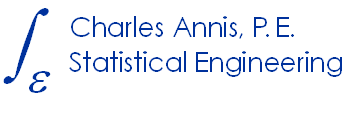Passages
Stages in an Engineer’s “understanding” of statistics in approximately chronological order
- Revelation that some constants, aren’t, and can be described by a Normal distribution.
- Discovery that there are other distributions too.
- Discovery that “statistics” and “probability” are not synonyms.
- Collecting as many different distributions as possible, and then using only the Normal.
- Search for a method for cataloging distributions to assign them to specific physical phenomena, then using the Weibull for everything.
- Discovery that all distributions are not continuous, but then using their normal “approximation” anyway.
- Discovery of the bivariate Normal distribution, and the correlation coefficient.
- Discovery of the multivariate Normal distribution.
- Discovery of Bayes’s theorem and A. W. F. Edwards’s attempt to avoid being a Bayesian using Fiducial distributions.
- Discovery of Fisher’s likelihood and its relation to be behavior of a distribution’s parameters.
- Discovery of the Fisher Information and the Cramér–Rao lower bound – that the variance of any unbiased estimator is at least as large as the inverse of the Fisher information.
- Discovery of Bayesian (subjective) probability.
- Disappointment in the practical difficulties of actually using Bayesian ideas.
- Recognition that variables might not be independent, and “correcting” for this by rotation of axes.
- Discovery that the correlation coefficient describes only a LINEAR relationship between two variables.
- Reluctant realization that rotation of axes, while intellectually appealing, is often useless.
- Grudging admission that perhaps the mathematical properties of functions of the data (statistics) might be practically useful and that you can’t master the topic with any less work that is required to master engineering.
- Recognition that some observations are more informative than others, and the idea of censored data.
- Re-discovery of Bayesian methods.
- Discovery that principal components analysis and “rotation of axes” can never be more than approximate models.
- Discovery of time-series methods to account for non-independence among observations close in time.
- Discovery of methods of spatial statistics to account for proximal observations being more alike than those at a distance.
(… to be continued.)

